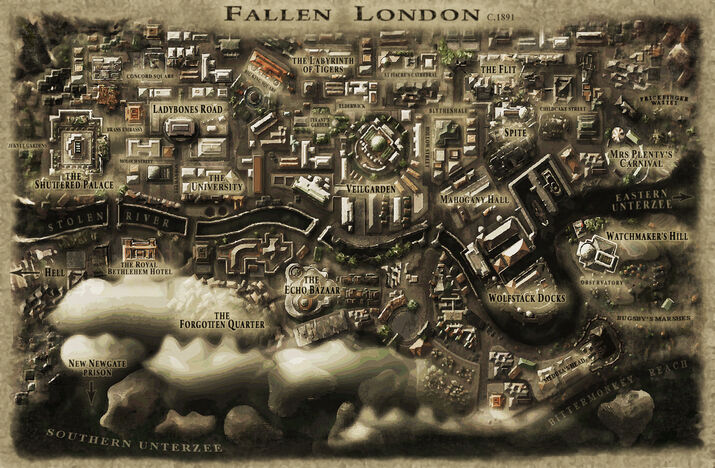Between the rearrangement of the Fall, the Masters’ prohibition of prelapsarian cartography, the curious limitations of memory, and the occasional impossible geometry, it can be hard to say exactly what is where and where is what in Fallen London. I’ve begun a project of recording every definite location in the city, and my best guess at what Surface-location - if any - it corresponds to. This originally began as a simple reference to lend colour and texture to my brother’s tabletop game, but it got big enough that my wife suggested I should post it here, and see if you lovely forum folk could contribute still further!
I should add that I’m not from the UK, and have never been to London, so my frame of reference is only what knowledge I have previously absorbed and what has been readily accessible through the net. So, I can only apologise for any comical blunders! Also, the precise borders between the districts of London - aside from the river - are not always clear, so locations near the border are subject to some guesswork.
The West End
Ladybones Road. i[/i]
Moloch St - home of the Honey-Addled Detective. (Baker Street)
Hood’s Bridge. (Waterloo Bridge)
Varlet’s Walk - location of Orchard House, HQ of the Dilmun Club
Jekyll Gardens. (Hyde Park)
Concord Square - police headquarters. (Based on Scotland Yard?)
Hastings Place - embassies, statue of Weeping Harold
Kidderghast Lane
Hangman’s Arch. (Marble Arch)
The Brass Embassy.
The Shuttered Palace. (Kensington Palace?)
The University (University of London)
Benthic College (University College)
Summerset College (King’s College)
Dropsy Hall - university building
Misery House - university building
Versification House - Home of the Imperial Artist-in-Residence
St Nathanael’s Hospital (St Bartholomew’s Hospital)
Caligula’s Coffee House - upmarket cafe
Dante’s Grill - devils’ diner
The New Justice - police pub
Clathermont’s Tattoo Parlour
Central London
Veilgarden (Covent Garden)
Elderwick - a church, booksellers, artists’ lodgings
Heartscross Hill - location of Heartscross Cemetery (Highgate, and Highgate Cemetery?)
Burly Street - Foreign Office; Captivating Princess’ green-doored honey-den
Hollow Street - elite honey-dens here
Grabskirt Lane (presumably related to Gropecunt Lane and its ilk)
Big King Square - favoured for weasel-fights, has a well
Tyrant’s Gardens - favoured for clandestine meetings (perhaps Regent’s Park?)
Wilmot’s End - adjoins Tyrant’s Gardens (perhaps Primrose Hill?)
The Labyrinth of Tigers - combined zoo, market and prison (The Zoological Society Gardens, AKA the ‘Zoo’)
St Aegidius’ Church (St Giles-in-the-Fields, AKA the Poets’ Church)
Church of St. Vincent of Saragossa (patron saint of vintners, associated with ravens)
The House of Chimes - a club in the River (the tower of Big Ben, sunk under the Thames)
The Parlour of Virtue - the city’s major bordello
The Singing Mandrake - bohemian pub
The East End
Spite i[/i]
Blythenhale - toughest cats (maybe Bethnal Green?)
Flowerdene Street - worst rookery in London (Flower and Dean Street - Ripper heartland)
Flowerdene Avenue
The Tenterhooks - dyeing industry (the Tentergrounds)
Smashtile Alley - ceramics industry (perhaps Brick Lane?)
Doubt Street - presses and printers (Fleet Street)
Deviltry Lane
St Fiacre’s Cathedral (real saint, but no such cathedral - presumably St Paul’s)
All Christs’ Church (perhaps All Souls’?)
St Dunstan’s Church - spirifer-den (St Dunstan-in-the-West)
Spite Market (Old Spitalfields Market?)
The Bone Bell (perhaps the Bow bells of St Mary-le-Bow, Cheapside?)
The Doubt Street Scullery - rough chop house
Mahogany Hall - largest music hall in London (Wilton’s Music Hall)
The Orphanage
Wolfstack Docks (The Isle of Dogs)
The Blind Helmsman - sailor’s pub
South London
The Bazaar
Blackfinger Street - Bookshops, printers, publishers, bookbinders
Southwark Cathedral
The Royal Bethlehem Hotel (Bethlem Royal Hospital, Southwark)
The Horse-Steak Club - elite, expensive club
The Bridge Without - expensive, uncomfortable pub; meeting place of movers and shakers
The Great Downward Engineering Company
The Greyfields Winery
South-East London
Watchmaker’s Hill (Greenwich)
Charley Square - centre of revolutionary soapboxing, has a well
The Observatory (Royal Observatory, Greenwich)
The Department of Menace Eradication (probably the Queen’s House, Greenwich)
The Gamekeeper’s Cottage (Might be the Ranger’s House?)
The Medusa’s Head - The Cheery Man’s pub - centre of his criminal empire.
Bugsby’s Marshes (real marshes, surrounding Greenwich)
Unknown
Hookman House - Main archive of Ministry of Public Decency
The Bishop’s Eye - pub
Antimacassar Theatre (I wonder if the antimacassars are delivered on a D’Oyly Carte)
Old Empress Theatre
Imperial Opera House (presumably the Royal Opera House, Covent Garden)
Cavalier House - fashionable salon
Chalkery Road - modestly respectable residences
Wick Street & Hobbe Lane - urchin territory
Alley Alley & Blue Ghost Street - urchin territory
Bad Monkey Row - possibly a delusion
Cake Street
Cubit Square - house of Mr Leadbeater here
Furnace Street - has “mirrored gin-palaces”
Childcake Street - has a well
Tollway Street - has a honey-den
The Museum of Mistakes
The Royal Portrait Gallery
The Square of Lofty Words
St Giles’ Bible College
Parliament House (possibly not Westminster Palace, if Big Ben is in the Thames)
edited by Sir Frederick Tanah-Chook on 11/8/2013
